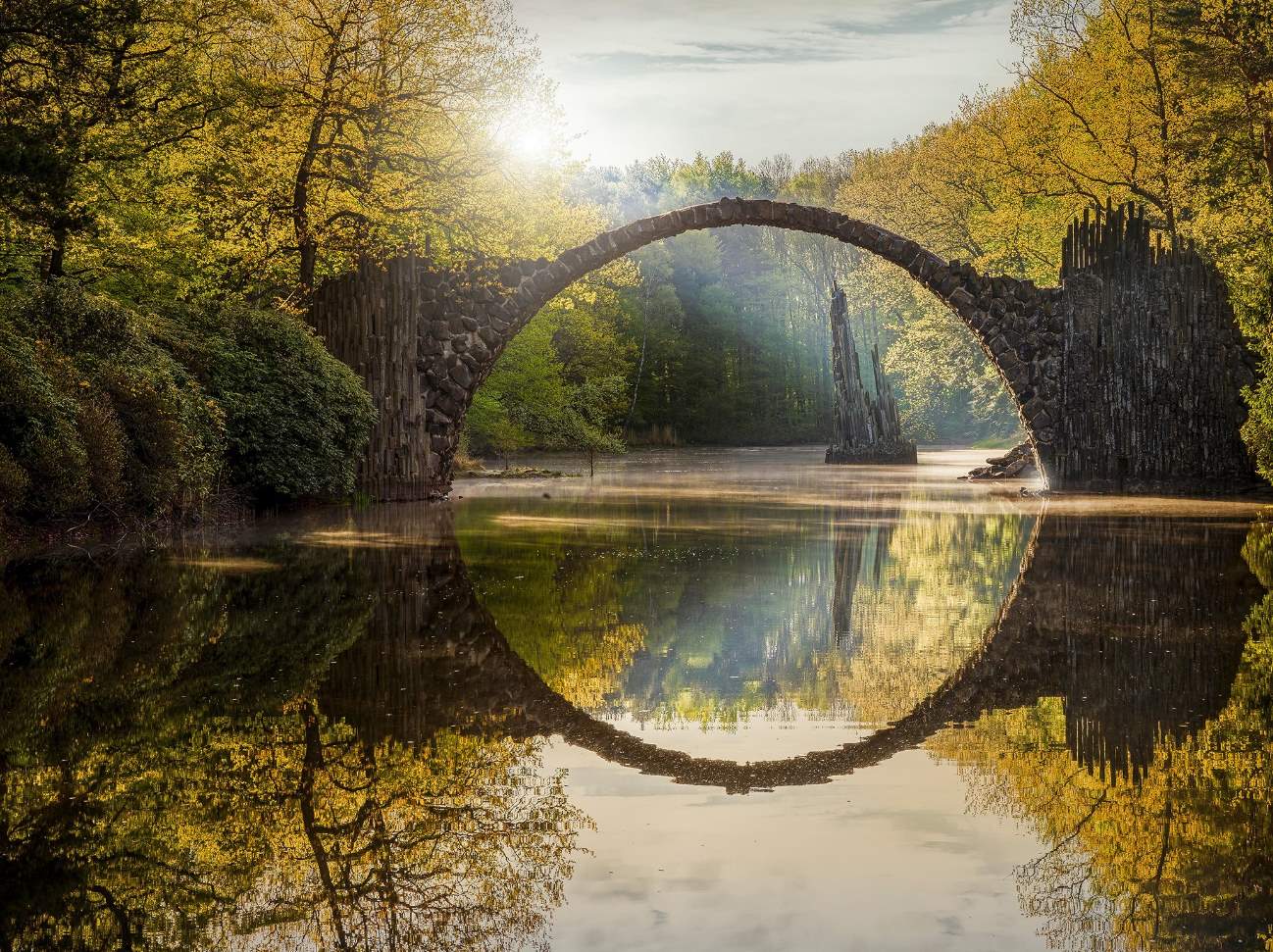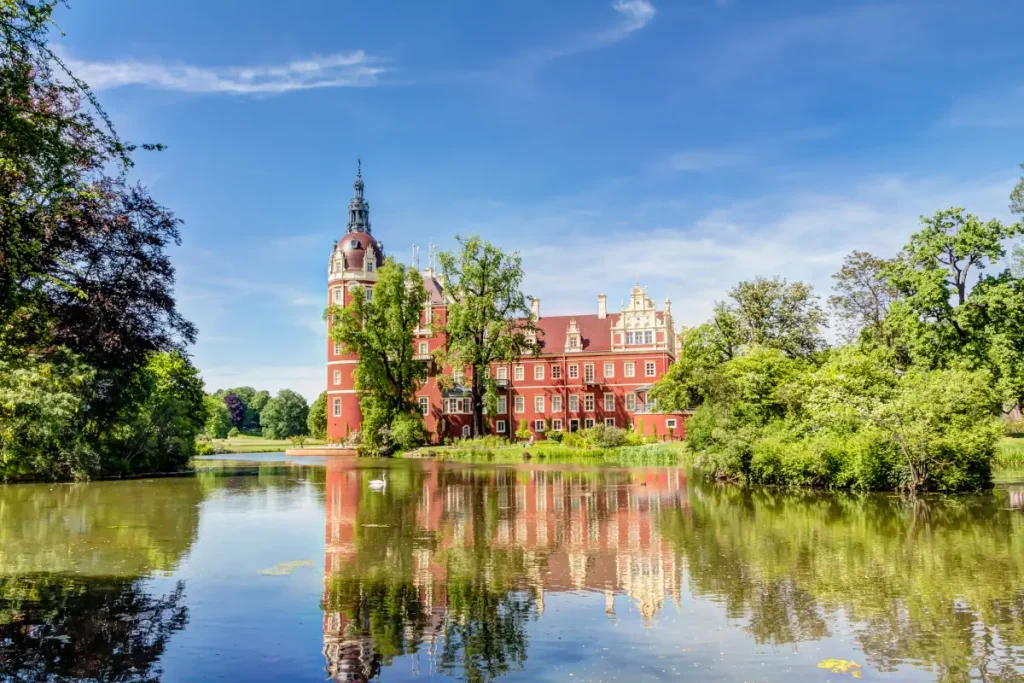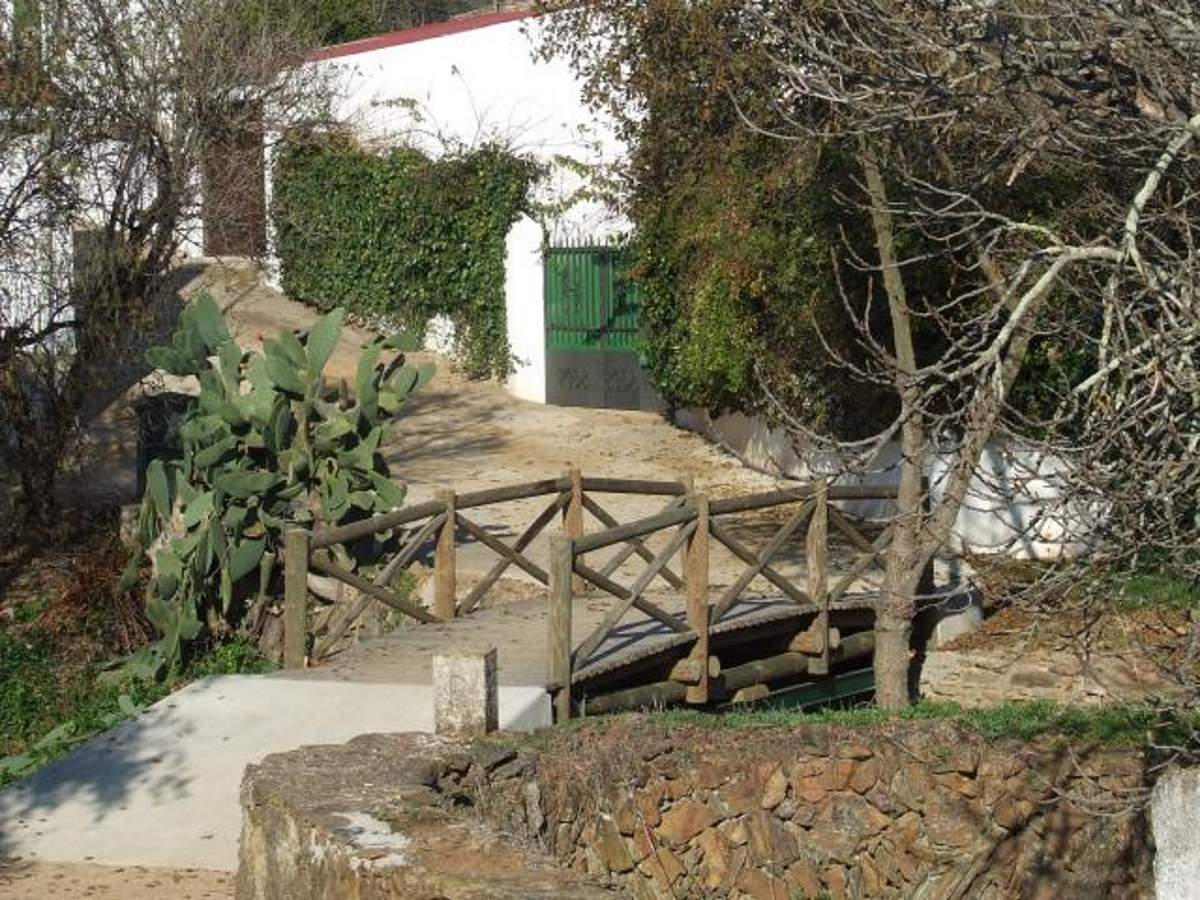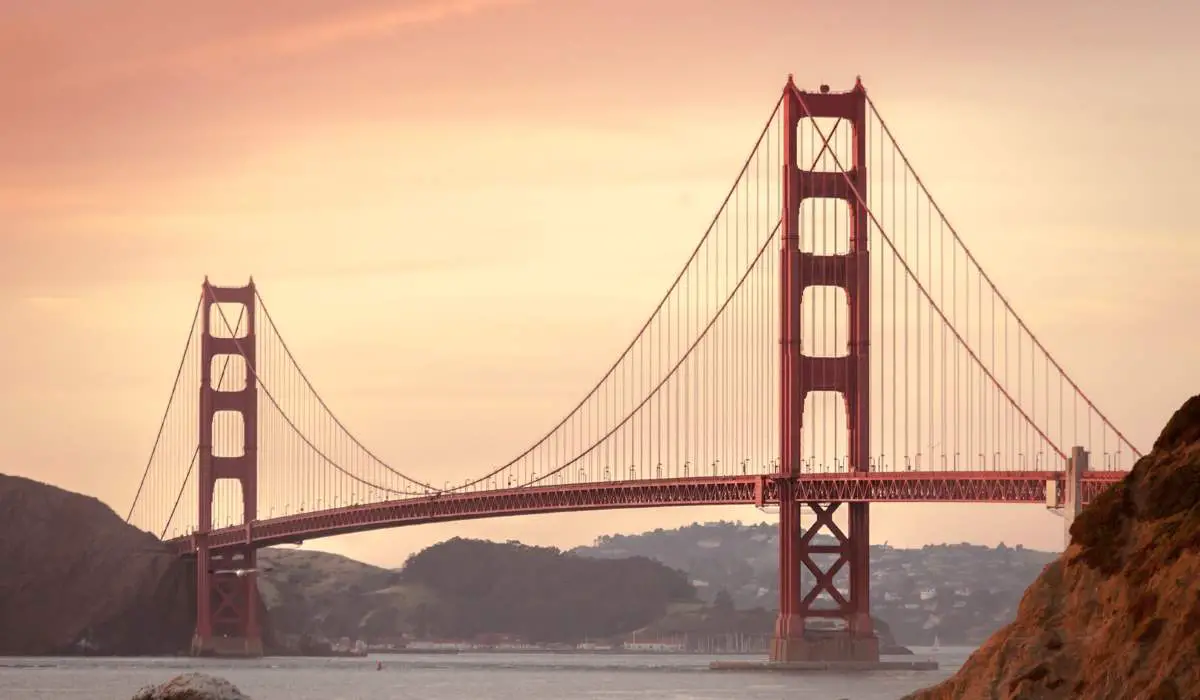Hidden deep within the enchanting Kromlau Park in Saxony, Germany, lies a whimsical gem that seems plucked from the pages of a storybook. Rakotzbrücke, also known as the Devil’s Bridge, is a breathtaking architectural marvel that captivates visitors with its otherworldly beauty and seemingly impossible symmetry. This extraordinary bridge, constructed in the 19th century, showcases a delicate balance between human ingenuity and the ethereal wonders of nature, creating an atmosphere that transports visitors into a realm where reality and fantasy intertwine. Whether you are an ardent traveler seeking hidden gems or simply a lover of picturesque landscapes, Rakotzbrücke promises an unforgettable experience that will leave you spellbound and yearning for more.
The Arch Bridge in Kromlau, Germany: Rakotzbrücke
Rakotzbrücke (English: Rakotz Bridge) is an arch-shaped bridge in the Azalea and Rhododendron Park Kromlau, a 200-acre (81 ha) landscaped park in the municipality of Gablenz, Saxony, Germany. The park and the bridge were built in the 19th century. Like many other spooky bridges in Europe, it’s nicknamed The Devil’s Bridge.

The ingenious construction of the Rakotzbrücke is nothing short of a stroke of architectural brilliance. Its semi-circular shape was carefully chosen to create a mesmerizing illusion that leaves visitors spellbound. When observed from the ideal vantage point, where the bridge aligns precisely with the mirrored surface of the waters below, an extraordinary spectacle unfolds – a complete circle formed by the bridge and its reflection. It is as if reality and fantasy merge, defying the conventional boundaries of perception. This deliberate design choice lends Rakotzbrücke an air of enchantment, transforming it into a gateway that transports visitors into a realm where imagination reigns supreme.
The Dance of Light and Reflection
The magical transformation of the Rakotzbrücke into a perfect stone circle is intricately tied to the interplay of light and reflection. As sunlight bathes the bridge, casting its radiant glow, the mirrored surface of the water becomes a canvas for nature’s illusion. When the conditions align and the observer discovers the precise angle of view, an astonishing alchemy takes place. The bridge’s curvature seamlessly merges with its reflection, giving birth to a complete circle of stone, seemingly suspended in a world beyond our own. This ephemeral moment of grace evokes a sense of wonder and awe, leaving spectators to marvel at the artistry of the human hand and the wonders of the natural world.
Beyond Illusion: A Symbolic Tapestry
The Rakotzbrücke, with its ethereal illusion, carries not only visual splendor but also profound symbolic significance. In folklore, Devil’s Bridges were said to have been constructed with supernatural aid, and the Rakotzbrücke lives up to its namesake by captivating and tempting onlookers with its enchanting allure. This bridge, through its illusory completeness, symbolizes the eternal cycle of life, the unity of nature’s elements, and the delicate balance between the seen and unseen. It serves as a poignant reminder of the beauty and fragility of existence, inviting contemplation and reflection on the deeper mysteries that lie beneath the surface.
The bridge’s artificially-formed basalt columns were specially shipped from distant quarries.
The park has no entry fee and can be accessed at any time. But, in order to preserve it, today, crossing the bridge is prohibited.
Why it was nicknamed the Devil’s Bridge?
Rakotzbrücke actually means the “cancer bridge”. Rakotz means “cancer” in the Sorbian language, a West Slavic language spoken by the Sorbs, a West Slavic minority in the Lusatia region of eastern Germany.
Rakotzbrücke is nicknamed the “devil’s bridge” because of the belief that the magical circle must be created by the hands of the devil. There are also other (more than a hundred) Devil’s bridges in Europe as well. In only France, there are 49 Devil’s Bridges!
Each of the Devil’s bridges typically has a corresponding Devil-related myth or folktale regarding its origin. Most of these bridges are stone or masonry arch bridges and represent a significant technological achievement in ancient architecture.
Some have the Devil as the builder of the bridge, relating to the precariousness or impossibility of such a bridge to last or exist in the first place, so much so that only the Devil himself could have built it. Others have the knowledge to build such bridges given to humankind as a gift from the Devil as part of the deal, pact, or bargain between the Devil and the local populace, usually in exchange for their souls.
Rakotzbrücke falls into that second group. According to a local legend, it was built by a knight named Friedrich with the help of Satan himself.
![The Arch Bridge in Kromlau, Germany: Rakotzbrücke [Devil's Bridge]](https://ourplnt.com/wp-content/uploads/2016/07/rakotzbrucke-1024x683.webp)
To photograph the bridge with a perfect circular reflection, the best time is spring or Autumn. In winter, the lake underneath the bridge usually gets frozen and covered with snow, which makes it hard to see the reflections. In summer, there might be no water at all.
In autumn, the foliage adds an element of wonder to the already surreal view.
You may wonder if it’s worth making the trip to Kromlau to see Rakotzbrücke. The answer is yes because this bridge is just too beautiful not to be seen.
Video: Rakotzbrücke in 4k Ultra HD
Azalea and Rhododendron Park Kromlau
The Azalea and Rhododendron Park Kromlau is a 200-hectare landscape park in the Kromlau district in Gablenz, Germany. It is considered the largest open-air rhododendrons as a landscape park in Germany and is always open with free admission.
The park was built in the 19th century.
In 1842 the rich landowner Friedrich Hermann Rötschke, a contemporary of the landscape designer Hermann Ludwig Heinrich Prince von Pückler-Muskau, acquired the Kromlau estate. From 1844, with the first planting of native and foreign trees on this property, Rötschke made almost half of his property available to design the park.
Basalt stones were fetched with ox carts from various quarries in Saxon Switzerland and Bohemia. The hexagonal basalt steles gave rise to caves, grottos, and pyramids, the judge’s chair, the organ, and “heaven and hell”, in the water and on land.
After the Second World War, Kromlauer Park was made public property due to the land reform and declared a nature reserve in 1948. The targeted maintenance and reconstruction of the park only began in 1966. Today the municipality of Gablenz is the owner of Kromlauer Park.
Rakotzbrücke is among the most interesting buildings in the park.
Renovation work of the Rakotzbrücke

The renovation work started on August 11, 2017. It was financed by the federal and state programs “Urban Monument Protection” and “Future City Green” in the amount of 2.4 million euros and 2.7 million euros, respectively.
In addition to the renovation of the Rakotz ensemble (Rakotzbrücke itself, a group of basalt columns, and the cave between the Rakotz Bridge and the outside staircase, which collapsed in 1956), the park paths and the stone group “Richterstuhl” in the western part of the park were also renovated.
The historical bridge on the island pond, also in the western part, was rebuilt and historical sculptures were restored. A multi-generation playground near the castle was completed in 2018. The visitor parking lot was also expanded, including the construction of an information point with a toilet facility.
The scaffolding around the bridge was removed in November 2020. Then the Rakotzsee was sealed in order to guarantee a constant water level and thus to bring out the mirror effect.
After the completion of all renovation work, the official re-release by Prime Minister Michael Kretschmer took place on July 10, 2021.
Muskau Park
You can also visit Muskau Park nearby, the largest and one of the most famous English gardens in Central Europe. It was added to the list of UNESCO World Heritage Sites in July 2004. It is a cross-border cultural collaboration between Poland and Germany. It covers 3.5 square kilometers (1.4 sq mi) of land in Poland and 2.1 km2 (0.81 sq mi) in Germany. It extends on both sides of the Neisse River, which constitutes the border between the countries.
The park also stands as one of Poland’s official Historic Monuments, as designated on May 1, 2004, and tracked by the National Heritage Board of Poland.

Sources
- “Rakotzbrücke: The Devil’s Bridge in Germany” on the Swedish Nomad website
- “Visiting Rakotzbrücke Devil’s Bridge, Saxony Germany” on the Whole World is a Playground website
- Devil’s Bridge on Wikipedia
- Rakotzbrücke Devil’s Bridge on Atlas Obscura
- Muskau Park on Wikipedia
- Rakotzbrücke: The Devil’s Bridge in Germany on Christine Abroad website
- How Many Elephants are Left in the World in 2025? - August 17, 2025
- Moon Landings: All-Time List [1966-2025] - February 2, 2025
- What Is Max-Q and Why Is It Important During Rocket Launches? - January 16, 2025
![The Arch Bridge in Kromlau, Germany: Rakotzbrücke [Rakotz Bridge]](https://ourplnt.com/wp-content/uploads/2016/07/Rakotz-Bridge-arch-bridge-in-Kromlau-Germany.jpg)

